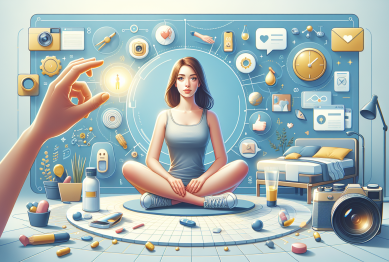In the digital age, technology has become deeply integrated into almost every aspect of our lives. From social media to work tools, smartphones to smart homes, we rely on technology daily. However, as much as it has improved productivity and connectivity, the constant presence of technology can also lead to stress, burnout, and a lack of mindfulness. In this article, we will explore how to balance technology with mindful living to ensure that we reap the benefits of both while maintaining a sense of well-being and presence.

Why Balancing Technology and Mindfulness is Important
Technology has many advantages—efficiency, connectivity, and access to information—but it can also be overwhelming. The constant barrage of notifications, emails, and digital distractions can make it difficult to be present in the moment. Mindfulness, on the other hand, focuses on being fully engaged in the present without judgment. Finding a balance between the two allows you to enjoy the benefits of technology while maintaining emotional well-being, improving focus, and reducing stress.
Key Benefits of Balancing Technology with Mindful Living
-
Reduced Stress: By limiting digital distractions and practicing mindfulness, you can reduce stress and anxiety.
-
Improved Focus: Balancing technology use allows for better concentration on tasks and enhances productivity.
-
Better Relationships: Mindfulness encourages deeper connection with others by fostering authentic, undistracted communication.
-
Enhanced Well-Being: Mindful technology usage can improve mental clarity, creativity, and overall emotional health.
For more on the connection between mindfulness and mental health, read Psychology Today’s article on How Technology Affects Mental Health.
Strategies for Balancing Technology with Mindful Living
1. Set Boundaries for Screen Time
One of the easiest ways to balance technology with mindful living is to set clear boundaries for screen time. By limiting the amount of time spent on digital devices, you can create space for other meaningful activities and experiences.
-
Create Digital Detox Zones: Set boundaries for where and when you use technology. For example, avoid checking emails or social media right after waking up or before going to bed.
-
Use Screen Time Tracking Apps: Use apps like Screen Time (iOS) or Digital Wellbeing (Android) to monitor and limit your screen time.
-
Scheduled Breaks: Take regular breaks throughout the day to step away from screens, reducing eye strain and mental fatigue.
For more on managing screen time, check out NPR’s Guide to Digital Detox.
2. Practice Mindful Technology Usage
Mindfulness doesn’t mean completely avoiding technology—it’s about how you use it. Be intentional about when, how, and why you engage with digital tools to avoid mindless scrolling and distractions.
-
Mindful Social Media Use: Set specific times for checking social media rather than scrolling mindlessly throughout the day. Be aware of how social media affects your mood and mental state.
-
Purposeful Internet Browsing: Instead of mindlessly browsing the internet, be intentional with your searches. Focus on learning, personal development, or entertainment that brings you joy.
-
Use Technology for Positive Habits: Use apps that promote mindfulness, such as meditation apps (Headspace, Calm) or productivity tools (Todoist, Notion).
For more on mindful technology usage, read Mindful Techie’s Tips for Using Technology Mindfully.
3. Implement Tech-Free Zones in Your Home
Creating tech-free zones in your home encourages relaxation and connection. These spaces can become sanctuaries where you can recharge without the distractions of digital devices.
-
Dining Areas: Designate your dining area as a no-phone zone to encourage family meals and meaningful conversations.
-
Bedroom: Keep your bedroom free from devices to promote better sleep hygiene and create a peaceful environment.
-
Living Room or Reading Nook: Set aside a space for quiet activities like reading, meditation, or engaging in hobbies, free from the influence of screens.
For more on creating a tech-free home, read HGTV’s Tips on Designing Tech-Free Spaces.
4. Prioritize Face-to-Face Connections
While technology has made communication more accessible, it often takes away the depth and authenticity of face-to-face interactions. Foster genuine relationships by prioritizing in-person communication whenever possible.
-
Offline Socializing: Plan social activities that don’t involve screens, such as hiking, cooking dinner together, or playing board games.
-
Active Listening: When engaging in conversations, give the person your full attention, avoiding distractions like phones or notifications.
-
Balance Virtual and Real Interactions: If you’re working remotely, schedule regular video calls or in-person meetings to maintain meaningful connections with colleagues or clients.
For more on fostering real relationships in a digital age, check out The New York Times’ Article on Building Meaningful Relationships.
5. Engage in Offline Activities that Foster Mindfulness
To reduce reliance on technology, it’s important to engage in offline activities that help cultivate mindfulness. Activities like yoga, walking, journaling, or even just sitting in silence can help center your thoughts and improve your emotional health.
-
Mindful Movement: Activities like yoga or Tai Chi can improve mental clarity while helping you reconnect with your body and mind.
-
Nature Walks: Spending time in nature helps you disconnect from digital distractions and tune into the present moment.
-
Journaling: Writing down thoughts, goals, or gratitude lists is a powerful way to stay grounded and mindful without the interference of technology.
For more on mindfulness practices, see Mindful’s Guide to Mindful Living.
6. Leverage Technology for Mindful Living
While technology can be a source of distraction, it can also support mindfulness practices. There are apps, online courses, and tools designed to help you lead a more mindful and balanced life.
-
Meditation Apps: Apps like Headspace, Calm, or Insight Timer offer guided meditations that can help reduce stress and improve focus.
-
Sleep Monitoring Tools: Devices like the Oura ring or apps like Sleep Cycle can help you track and improve your sleep patterns.
-
Time-Management Apps: Tools like Trello or Todoist help you stay organized, manage tasks, and reduce the mental clutter that often leads to stress.
For more on how technology can enhance mindfulness, check out Forbes’ Guide to Mindful Tech.
Conclusion: Achieving Balance Between Technology and Mindfulness
In a world dominated by technology, finding a balance between digital engagement and mindful living is crucial for mental well-being. By setting boundaries, using technology intentionally, and prioritizing offline activities, you can create a lifestyle that enhances both productivity and peace of mind. As technology continues to evolve, adopting mindful approaches will help you harness its benefits while maintaining a sense of balance and presence in your daily life.
References:
-
Psychology Today. (2021). How Technology Affects Mental Health. Retrieved from https://www.psychologytoday.com/us/articles/mental-health
-
Mindful Techie. (2021). Using Technology Mindfully. Retrieved from https://www.mindfultechie.com/
-
NPR. (2021). Digital Detox and Mental Health. Retrieved from https://www.npr.org/









